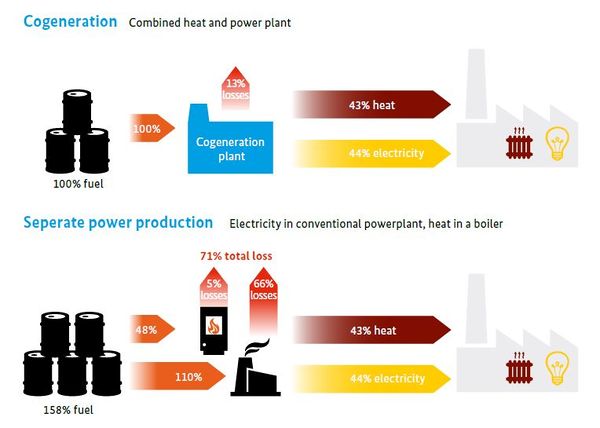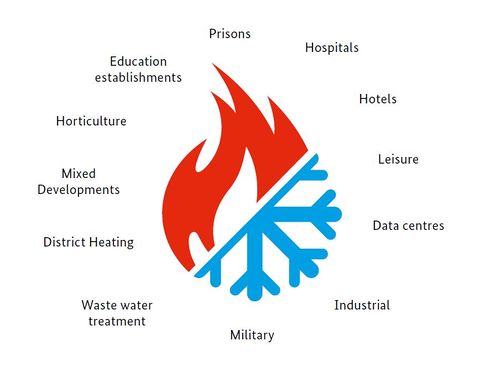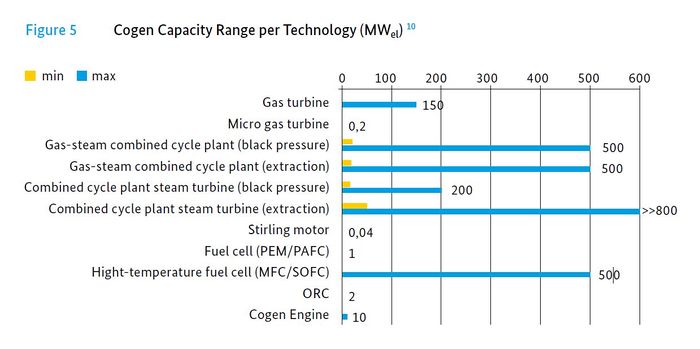Difference between revisions of "Cogeneration"
***** (***** | *****) |
***** (***** | *****) |
||
| Line 22: | Line 22: | ||
Another field of application with high potential is the use within the [[Bioenergy in Powering Agriculture|powering agriculture]] context: By employing cogeneration technology, food processing plants can utilize biomass by-products to generate heat and power, which in return can be used for the production process. <br/> | Another field of application with high potential is the use within the [[Bioenergy in Powering Agriculture|powering agriculture]] context: By employing cogeneration technology, food processing plants can utilize biomass by-products to generate heat and power, which in return can be used for the production process. <br/> | ||
| − | Obviously, | + | Obviously, cogeneration plants are ideally suited for on-site generation and thus can be an important building block for the establishment of an energy system based on distributed generation. System capacities depend on the field of application, but usually range between a few kilowatts electric (kW<sub>el</sub>) up to 20 megawatts electric (MW<sub>el</sub>) when regarding projects related to international development cooperation.<br/> |
[[File:Typical Applications for Cogen Technology.JPG|center|500px|alt=Typical Applications for Cogen Technology.JPG]]<br/> | [[File:Typical Applications for Cogen Technology.JPG|center|500px|alt=Typical Applications for Cogen Technology.JPG]]<br/> | ||
| Line 34: | Line 34: | ||
= Technologies<br/> = | = Technologies<br/> = | ||
| − | Cogen encompasses a wide range of proven technologies. Combined heat and power technologies can be divided into small scale applications, <font lang="ja" face="bundesserif-regular" size="2"><font lang="ja" face="bundesserif-regular" size="2">starting from some 1 kW</font></font><font lang="ja" face="bundesserif-regular" size="1"><font lang="ja" face="bundesserif-regular" size="1">el</font></font><font lang="ja" face="bundesserif-regular" size="2"><font lang="ja" face="bundesserif-regular" size="2">engines that are usually focused on thermal energy supply, up to large-scale power</font></font><font lang="ja" face="bundesserif-regular" size="2"><font lang="ja" face="bundesserif-regular" size="2">plants mainly focused on electric power production. These types of cogen plants can</font></font><font lang="ja" face="bundesserif-regular" size="2"><font lang="ja" face="bundesserif-regular" size="2">be differentiated by technology and feasible capacity, as illustrated below.</font></font><br/> | + | Cogen encompasses a wide range of proven technologies. Combined heat and power technologies can be divided into small scale applications, <font lang="ja" face="bundesserif-regular" size="2"><font lang="ja" face="bundesserif-regular" size="2">starting from some 1 kW</font></font><font lang="ja" face="bundesserif-regular" size="1"><font lang="ja" face="bundesserif-regular" size="1">el </font></font><font lang="ja" face="bundesserif-regular" size="2"><font lang="ja" face="bundesserif-regular" size="2">engines that are usually focused on thermal energy supply, up to large-scale power</font></font><font lang="ja" face="bundesserif-regular" size="2"><font lang="ja" face="bundesserif-regular" size="2">plants mainly focused on electric power production. These types of cogen plants can</font></font><font lang="ja" face="bundesserif-regular" size="2"><font lang="ja" face="bundesserif-regular" size="2">be differentiated by technology and feasible capacity, as illustrated below.</font></font><br/> |
| − | [[File:Cogen Capacity Range per Technology.JPG|center|700px|alt=Cogen Capacity Range per Technology.JPG]] | + | [[File:Cogen Capacity Range per Technology.JPG|center|700px|alt=Cogen Capacity Range per Technology.JPG]] |
<br/> | <br/> | ||
| − | <br/> | + | = Fuels<br/> = |
| + | |||
| + | <font lang="ja" face="bundesserif-regular" size="2"><font lang="ja" face="bundesserif-regular" size="2">As possible plant sizes vary depending on the technology, so does the choice of fuel.</font></font><font lang="ja" face="bundesserif-regular" size="2"><font lang="ja" face="bundesserif-regular" size="2">Waste heat recovery and thus cogeneration can be operated in all types of combustion</font></font><font lang="ja" face="bundesserif-regular" size="2"><font lang="ja" face="bundesserif-regular" size="2">processes and fuels.</font></font><font lang="ja" face="bundesserif-regular" size="2"><font lang="ja" face="bundesserif-regular" size="2">The choice of fuel is subject to fuel availability</font></font><font lang="ja" face="bundesserif-regular" size="2"><font lang="ja" face="bundesserif-regular" size="2">and costs</font></font><font lang="ja" face="bundesserif-regular" size="2"><font lang="ja" face="bundesserif-regular" size="2">as well as technological and economic optimisation. Common types of fuels are:</font></font><br/> | ||
| − | + | *<font lang="ja" face="bundesserif-regular" size="2"><font lang="ja" face="bundesserif-regular" size="2">Coal</font></font><br/> | |
| + | *<font lang="ja" face="bundesserif-regular" size="2"><font lang="ja" face="bundesserif-regular" size="2">Natural gas</font></font><br/> | ||
| + | *<font lang="ja" face="bundesserif-regular" size="2"><font lang="ja" face="bundesserif-regular" size="2">Heating oil</font></font><br/> | ||
| + | *<font lang="ja" face="bundesserif-regular" size="2"><font lang="ja" face="bundesserif-regular" size="2">Vegetable oil</font></font><br/> | ||
| + | *<font lang="ja" face="bundesserif-regular" size="2"><font lang="ja" face="bundesserif-regular" size="2">Bioethanol</font></font><br/> | ||
| + | *<font lang="ja" face="bundesserif-regular" size="2"><font lang="ja" face="bundesserif-regular" size="2">Biogas</font></font><br/> | ||
| + | *<font lang="ja" face="bundesserif-regular" size="2"><font lang="ja" face="bundesserif-regular" size="2">Biomass</font></font><br/> | ||
| + | *<font size="2">Municipal waste</font><br/> | ||
| − | <br/> | + | <font size="2"></font><br/> |
| + | <font size="2"></font> | ||
| + | <font lang="ja" face="bundesserif-regular" size="2"><font lang="ja" face="bundesserif-regular" size="2">Coal is the dominant fuel for large-scale cogen (> 50 MW</font></font><font lang="ja" face="bundesserif-regular" size="1"><font lang="ja" face="bundesserif-regular" size="1">el</font></font><font lang="ja" face="bundesserif-regular" size="2"><font lang="ja" face="bundesserif-regular" size="2">) in the power sector, whereas</font></font><font lang="ja" face="bundesserif-regular" size="2"><font lang="ja" face="bundesserif-regular" size="2">natural gas and biomass are common in smaller-scale applications.</font></font><br/> | ||
| + | <font size="2">Not listed above for lack of a real fuel, cogeneration can also be applied to steam turbines being part of a concentrated solar power (CSP) plant.</font><br/> | ||
| + | <font size="2"></font> | ||
<br/> | <br/> | ||
| Line 87: | Line 100: | ||
<references /> | <references /> | ||
| − | |||
| − | |||
| − | |||
| − | |||
| − | |||
| − | |||
| − | |||
Revision as of 14:00, 22 June 2016
Overview
Cogeneration or combined heat and power (CHP) is the use of a heat engine to simultaneously generate both electricity and useful heat.
Thermal power plants and heat engines in general, do not convert all of the available primary energy into electricity. In most heat engines, more than 50% of the primary energy is wasted as excess heat. By capturing the excess heat, CHP uses heat that would be wasted in a conventional power plant, potentially reaching an efficiency of up to 70%, compared with at most 40% for the conventional plants. This means that less fuel needs to be consumed to produce the same amount of useful energy. As well, less pollution is produced for a given economic benefit.
Applications
Cogeneration technology is applicable in a wide range of sector segments as shown in the figure below. For instance, cogeneration plants are commonly found in central heating systems for hospitals, hotels and industrial plants with large heating needs adding to their electricity demand.
Another field of application with high potential is the use within the powering agriculture context: By employing cogeneration technology, food processing plants can utilize biomass by-products to generate heat and power, which in return can be used for the production process.
Obviously, cogeneration plants are ideally suited for on-site generation and thus can be an important building block for the establishment of an energy system based on distributed generation. System capacities depend on the field of application, but usually range between a few kilowatts electric (kWel) up to 20 megawatts electric (MWel) when regarding projects related to international development cooperation.
Technologies
Cogen encompasses a wide range of proven technologies. Combined heat and power technologies can be divided into small scale applications, starting from some 1 kWel engines that are usually focused on thermal energy supply, up to large-scale powerplants mainly focused on electric power production. These types of cogen plants canbe differentiated by technology and feasible capacity, as illustrated below.
Fuels
As possible plant sizes vary depending on the technology, so does the choice of fuel.Waste heat recovery and thus cogeneration can be operated in all types of combustionprocesses and fuels.The choice of fuel is subject to fuel availabilityand costsas well as technological and economic optimisation. Common types of fuels are:
- Coal
- Natural gas
- Heating oil
- Vegetable oil
- Bioethanol
- Biogas
- Biomass
- Municipal waste
Coal is the dominant fuel for large-scale cogen (> 50 MWel) in the power sector, whereasnatural gas and biomass are common in smaller-scale applications.
Not listed above for lack of a real fuel, cogeneration can also be applied to steam turbines being part of a concentrated solar power (CSP) plant.
Efficiency
CHP is most efficient when the heat can be used on site or very close to it. Overall efficiency is reduced when the heat must be transported over longer distances. This requires heavily insulated pipes, which are expensive and inefficient; whereas electricity can be transmitted along a comparatively simple wire, and over much longer distances for the same energy loss.
Technology
There are two categories of cogeneration plants:
- Topping cycle - produces electricity first, and then the exhausted steam is used for heating. The hot water from condensed steam is well-suited for space and water heating.
- Bottoming cycle - produces high heats for an industrial process, and then a waste heat recovery boiler feeds an electrical plant. Bottoming cycle plants are only used when the industrial process requires very high temperatures, such as furnaces for glass and metal manufacturing hence rare.
Common CHP plant types are:
- Gas turbine CHP plants using the waste heat in the flue gas of gas turbines
- Combined cycle power plants adapted for CHP
- Steam turbine CHP plants that use the heating system as the steam condenser for the steam turbine.
Further Information
- Guide: Cogeneration & Trigeneration - How to produce energy efficiently (GIZ, 2016)
- wikipedia.org: Cogeneration
- cogen.org: what is CHP
- localpower.org






















